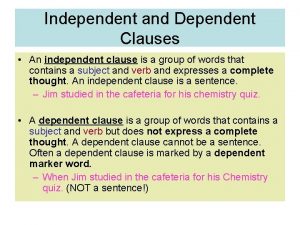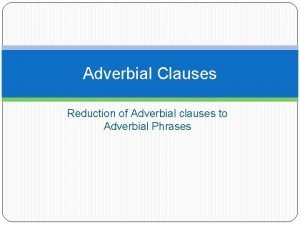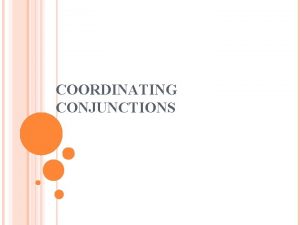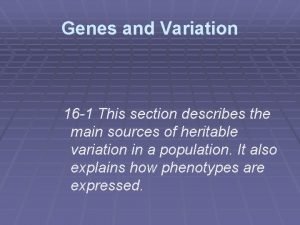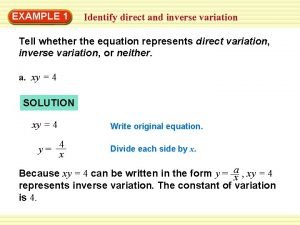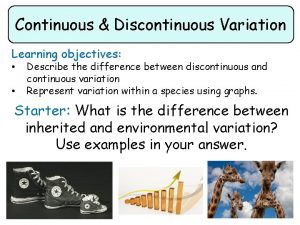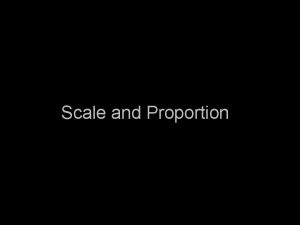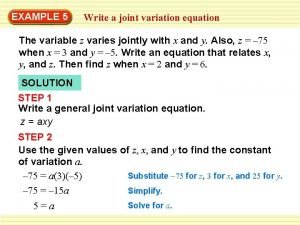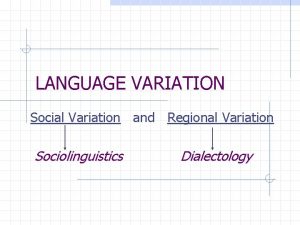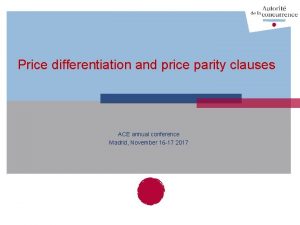Price Variation Clauses PV 1 and PV 2

































- Slides: 33

Price Variation Clauses “PV 1 and PV 2” Public Works Contracts Lisa Maloney, Byrne Wallace

Introduction Ø What is a Price Variation Clause? Ø Adjustment to the Contract Sum in PWC contracts Ø Operation and meaning of PV 1 and PV 2 Ø Claims under PV 1 and PV 2

Introduction Ø Price Variation Clauses PV 1 and PV 2 are used in the Public Works Contract forms PW-CF 1 – PW-CF 4 and PV 1 in PW-CF 5 as listed below:

What is a Price Variation Clause? Ø Sub-clause 10. 8 of the PWC deals with price variation Ø Included in the contract as stated in Schedule, part 1 M Ø Fixed-price lump-sum contracts - Contractor accepts risk of: Ø Increases in cost of labour; Ø Increases in cost of materials during the construction period (the inflation Ø risk); and Ø Certain risks of changes in law Ø Two approaches electable at the discretion of the employer: Ø PV 1 – The Proven Cost Method; or Ø PV 2 – The Formula Fluctuation Method;

What is a Price Variation Clause? Ø Decision on price variation options and compensation event must be taken prior to the publication of the tender invitation - result dictates what payments can be made outside of the fixed price Ø Must state whether PV 1 or PV 2 - to deal with price variation Ø Default option is PV 1

PV 1 - the “Proven Cost Method” Ø Invoice based system Ø Contractor establishes entitlement after fixed price period Ø Contractor provides evidence of: Ø invoices to support any claim for increases; Ø hyperinflation increases in relation to the cost of materials used in the works; and Ø cost of the materials at the Designated Date/Base Date. Ø Employer checks validity of claims independently Ø Employer obtains prices from suppliers for same materials, quantities and timeframes in comparison to the Contractor’s claim Ø Base Date under PV 1 – first day of the 31 st month after the Contract date February 25, 2021 6

PV 1 - the “Proven Cost Method” Ø Base Date - Guarantees Employer 30 month fixed price Ø No increase or decrease that comes into being after the Date for Substantial Completion shall be taken into account for the purpose of PV 1 Ø Difference (if any) in excess of 10% of normal inflation for materials is added to the Contract Sum and paid to the Contractor Ø Increases in cost of labour involves an increase in the Registered Employment Agreement (REA), now the Sectoral Employment Order (SEO), hourly labour rate after Base Date which is applied to hours worked after Base Date to determine amounts to be added Ø Under PW-CF 5 (Minor Works) – no choice as to method of calculation. PV 1 method only February 25, 2021 7

PV 2 - the “Formula Fluctuations Method” Ø Formulae under this method is based on calculations using appropriate amount of Contract Sum adjustment for recovery of material cost changes Ø Based on use of CSO price indices for different categories of materials, fuels and Consumer Price Index - as published the Central Statistics Office Ø Weighting for each material, fuel, labour, non-reusable temporary works and non-recoverable overheads are established by Employer Ø Proportions of different fuels and materials also defined within these indices – proportions provided in the invitation to tender (ITT) February 25, 2021 8

PV 2 - the “Formula Fluctuations Method” Ø Similar formula is used to determine permitted labour increases using the difference between the SEO hourly rate at the Base Date and the current SEO rate Ø PV 1 and PV 2 - Permitted increases applied to SEO rates at Base Date (for categories of workers for which recovery is permitted) are used to support Contract Sum adjustments for recovery of labour cost changes Ø If a choice of PV Clause is not indicated in Part 1 M of the Schedule (PW-CF 1 to PW-CF 4), the default is that PV 1 will apply Ø PV 1 and PV 2 is available with both traditional and design-and-build contracts; however, PV 2 difficult to use in design -and-build where Employer does not provide the relevant percentages and weightings in the Form of Tender and Schedule February 25, 2021 9

Adjustment to the Contract Sum for changes in cost in Contracts PW-CF 1 to PW-CF 4 Ø PW-CF 1 to PW-CF 4 must indicate the PV method to be used to calculate adjustments to the Contract Sum for changes to the cost of labour and materials Ø Any difference in excess of 10% of normal inflation for materials is added to the Contract Sum Ø Increase in cost of labour involves an increase in SEO, hourly labour rate after Base Date which is applied to hours worked after Base Date to determine amount to be added to Contract Sum

Cost risks for Contractor Ø Fixed-price lump-sum contract - Contractor accepts the following risks: Ø Increases in cost of labour and materials (the inflation risk) other than those increased by certain specified amounts (hyperinflation) and those outside the specified time period (fixed-price period); Ø Increases in cost due to changes in law other than in certain specified REAs (now SEOs); and Ø Increases in cost due to exchange rate variations Ø If impending legislation will increase cost of the project and legislation is referred to in the tender documents, it is good practice to ensure the Contractor is fully aware of the implications prior to award of contract and this is recorded in minutes and included in contract documents February 25, 2021 11

Base Date depends on which price valuation method is used: Ø PV 1 - first day of the 31 st calendar month after the Contract Date Ø PV 2 - Date of the first day of the 37 th calendar month after the Designated Date/Recovery Date Ø Contractor’s time for completion of the works (unless it is a fixed date) runs from the date when the Letter of Acceptance is issued Ø Base Date is only applicable in the following circumstances: Ø PV 2 - to contracts that are longer than 36 months duration from the Designated Date/Recovery date; and Ø PV 1 - to contracts that are longer than 30 months duration from the Contract Date

Inflation risk borne by the Contractor Ø Contractor tenders a fixed price Ø Price fixed for a defined fixed-price period Ø Within fixed price period - Contractor accepts risk of normal inflation Fixed-price period and commencement date depends on the Price Variation method chosen specified in the following table: February 25, 2021 13

Inflation risk borne by the Contractor Ø Designated Date is 10 days before latest date for receipt of tenders Ø Recovery Date is the Designated Date corrected to account for any delay to the commencement of the works resulting from actions or omissions of Contractor Ø If Contractor is responsible for delaying commencement of works after Contract has been awarded, the commencement of fixed-price period is deferred Ø Contractor is always entitled to compensation for hyperinflation and for inflation caused by changes of law February 25, 2021 14

Managing lead-in times for transfer of inflation risk Ø Delays between close of tendering process and award of Contract Ø PV 1 - 30 months fixed-price period always commences at the Contract Date so that the actual fixed-price period applying during project execution does not change no matter what length of time it takes to award contract Ø PV 2 - actual fixed-price period that applies during a project may be shortened if delay caused by Employer in awarding contract Ø E. G: if the planned project lead-in time is six months, the actual fixed-price period for project execution is 30 months (36– 6 = 30). However, if the planned lead-in time is extended by three months (to nine months) due to a delay by the Employer in awarding the Contract, the actual fixed-price period applying during project execution is reduced by three months to 27 months (36– 9 = 27) February 25, 2021 15

Ø Managing lead-in times for transfer of inflation risk Short contracts - reduction for PV 2, of the fixed-price period applying during the Contract, may not be an issue. If Contract will be completed within 30 -month period, it is possible in exceptional circumstances to have a planned lead-in time longer than 6 months Ø No case should lead-in period exceed 12 months Ø Contractors tendering for short-term contracts will know duration of those contracts and price expected cost increases in their tender for that period Ø Long contracts - important to minimise lead-in time (6 months maximum) for PV 2 to ensure that the longest possible period for fixed-price is available February 25, 2021 16

Managing lead-in times for transfer of inflation risk Ø Employer should carefully consider appropriate lead-in time for project Ø Important if project is governed by EU Procurement Directives Ø All projects, irrespective of size, are subject to the EU Treaty principles of transparency, nondiscrimination, proportionality, mutual recognition and equal treatment of tenderers Ø Lead-in time should not be confused with tender validity period - this should be stated in the tender documents February 25, 2021 17

Inflation risk exception: hyperinflation Ø What is hyperinflation? Ø Extremely rapid rise in market prices over a very short period of time Ø Contract entitles Contractor to recover costs at any time after the Designated/Recovery Date, for sudden market increases in the price of materials or fuel Ø Compensation payable is the amount calculated according to the Contract February 25, 2021 18

Measuring Hyperinflation Ø Hyperinflation of prices of material is measured by: Ø Checking price for the same quantity of the same material at the Designated Date and at the first day of the month in which the purchase was made; and selecting the highest of these prices; Ø Calculating the percentage increase in the price at the time of purchase in relation to that selected price; and Ø Checking if this percentage is greater than 50%, and noting the excess. Ø The amount of the adjustment to the Contract Sum is calculated by taking the amount by which that percentage change exceeds 50% and applying it (by addition) to the price at the Designated Date February 25, 2021 19

Exchange rate risk borne by Contractor Ø Request for tenders should state that all prices are to be given in euro and risk of currency fluctuations must be borne by Contractor Ø Tenders submitted in other currencies should not be accepted Ø No compensation is payable for changes in cost of materials, fuel or other prices due to variation in the currency exchange rate February 25, 2021 20

Risk of changes in law borne by Contractor & the Employer Ø Fixed-price lump-sum contracts - Contractor accepts risk of any cost increase arising out of changes in legislation during the lifetime of project Ø Exceptions - Contract Sum adjusted (increased or decreased) for the following changes: Ø Value Added Tax Ø Excise duty or similar tariffs Ø Pay-Related Social Insurance Ø Requirement for a licence to import any commodity – e. g. Brexit Ø Compensation only payable if Contractor has not already received compensation for these heading under Contract Ø Where Employer identifies any such changes in tender documents – e. g. reference to impending legislation, then no adjustment permitted when change occurs February 25, 2021 21

Data required for PV 2 Invitation to Tender (ITT) Ø PV 2 not used as much particularly Design & Build Contracts Ø Traditional contract - if Employer chooses to use PV 2 to deal with price variation, ITT should include filled in appendices from the Contract including: Ø Proportions of labour, materials, fuel, and non-adjustable overheads Ø Allocates a nominal percentage of Contract Sum to each of five (in the case of building works) or six (in the case of civil engineering) broad categories of work items (labour, materials, fuel, non-reusable temporary works, overheads and plant (only for civil engineering)) Ø Re overheads – e. g. 10% should be allocated to overhead costs that are not subject to price adjustment Ø Total of the percentages must equal 100 Ø Indices and weightings for materials and fuel Ø Allocates a nominal weighting to a range of material and fuel items that may be used on the project Ø Total of weightings for materials must equal 1, as must the total of the weightings for fuel Ø Prices of items in this list are tracked by the CSO, who publish the monthly price indices February 25, 2021 22

Data required for PV 2 Invitation to Tender Ø During the tender period, tenderers may be given an opportunity to comment on the Employer’s nominal percentages and weightings Ø Revisions to the percentages and weightings that the Employer wishes to make will be circulated not later than the time stated in the tender documents for issue of amendments Ø Completed appendices 2 and 3 should be contained within Pricing Document Ø Nominal percentages and weightings are not intended to be an exact representation of the actual use of materials etc. on the project; they are used solely to calculate price variation Ø Only categories of materials listed in the CSO monthly publication permissible February 25, 2021 23

Risk Management PV 2 Ø Section 1. 12 - PV 2 use of material and fuel categories Ø Section 1. 13 - PV 2 tender data in a traditional contract Ø Section 1. 14 - PV 2 weightings not required Ø Section 1. 15 - PV 2 data and the fixed-price period Ø Section 1. 16 - Offer period in Standard Form of Tender February 25, 2021 24

Calculating Price Variation under PV 1 Ø Fixed price for 36 months Ø Validation of Claims – invoices For From Hyperinflation and eligible changes in legislation The Designated Date (ten days before the closing date for receipt of tenders) Other eligible labour and material adjustments The Base Date Ø The price variation is measured as follows: February 25, 2021 25

Adjustments for Legislative Changes Ø Contract Sum may be adjusted to reflect impact on costs of: Ø Changes in VAT, customs or excise duties, requirements for a licence to import or export any commodity or Ø Changes to PRSI rates. Ø Legislative changes not identified in the Works Requirements February 25, 2021 26

Background to SEOs Ø Old Registered Employment Agreement ("REA") system set out in the Industrial Relations Act, 1946 Ø Supreme Court held that REAs were unconstitutional in Mc. Gowan v Labour Court[2013] IESC 21, [2013] 3 IR 718 Ø Court found REA system was an emanation of the legislative role being carried out inappropriately by an unelected Labour Court and other interested parties Ø In order to replace the old system the Government brought in a new Sectoral Employment Order system under the Industrial Relations (Amendment) Act, 2015 February 25, 2021 27

Sectoral Employment Order Ø Sectoral Employment Order (Construction Sector) 2017, S. I. No 455 of 2017 Ø Signed into law by Minister for State at the Department of Business, Enterprise and Innovation on 19 October 2017 Ø SEO governs rates of wages, pension contributions, travel time payments and similar allowances payable by contractors to operatives in the construction sector Ø SEO is a change in Law Ø Replaces Registered Employment Agreements - withdrawn in May 2013 Ø Main provisions Ø Outlines definitions for sector and categorises workers Ø Sets out new basic hourly rates of pay Ø Provides for unsocial hours payments Ø Sets terms for pension schemes Ø Sets terms for sick pay schemes Ø Outlines a dispute resolution procedure February 25, 2021 28

Effect of the SEO Ø Relevant construction industry employees entitled, as a minimum, to the pay and benefits set out in the SEO Ø Is a matter of contract as to whether or not a contractor entitled to recoup from employer the additional costs contractor will incur in performing a contract as a result of the SEO Ø Part 1 M of the Contract Schedule specifies which of the price variation options – PV 1 or PV 2 – is incorporated February 25, 2021 29

Effect of the SEOs on Public Works Contracts Ø PWCS place change of law for labour cost inflation as largely a contractor risk Ø Clause 5. 3. 2 (pay and conditions of employment) requires contractor to ensure rates of pay and conditions of employment comply with all applicable law (regardless of tendered rates) Ø PV 1 and PV 2 allow for adjustments only to contract sum for an increase in wage rate after the base date (defined as "the first date of the 31 st month after the Contract Date" under PV 1 and "the first day of the 37 th calendar month after the Designated Date" under PV 2) Ø Generally, the contract will have completed in advance of reaching relevant base date, which limits the application of this provision to a narrow set of contracts February 25, 2021 30

Contractor’s Claim Ø The Contractor should submit notices of claim to the Employer's Representative in accordance with clause 10. 3 of the Contract Ø The first such notice should ideally be submitted within 20 working days after the Contractor became aware, or should have become aware, of something that could result in an entitlement to an adjustment to the Contract Sum Ø Contractor should submit a notice of claim as soon as possible in order to maximise its chances of obtaining an adjustment to the Contract Sum on foot of an February SEO 25, 2021 31

Case Law Ø Mc. Gowen v Labour Court Ø Supreme Court found the regime of registered employment agreements unconstitutional Ø Lead to uncertainty on protection of wages and benefits of construction workers Ø Decision addressed by SEOs February 25, 2021 32

Thank you Questions? Lisa Maloney Solicitor, Construction lmaloney@byrnewallace. com + 353 1 691 5353 www. byrnewallace. com February 25, 2021 33
 Ipinapatupad ang price freeze ng pamahalaan kapag
Ipinapatupad ang price freeze ng pamahalaan kapag Direct variation
Direct variation Direct and inverse variation
Direct and inverse variation Coefficient of determination formula in regression
Coefficient of determination formula in regression Restrictive nonrestrictive clauses
Restrictive nonrestrictive clauses Dependent clause
Dependent clause Pv clause
Pv clause Reduced clause adalah
Reduced clause adalah Price discovery and price determination
Price discovery and price determination Marked price-selling price=
Marked price-selling price= Difference between hire purchase and installment
Difference between hire purchase and installment Reactive metal paint
Reactive metal paint Hooking up words
Hooking up words Stabilizing selection human birth weight
Stabilizing selection human birth weight Artificial selection vs natural selection
Artificial selection vs natural selection Intermediate inheritance
Intermediate inheritance This section describes
This section describes How to identify direct and inverse variation
How to identify direct and inverse variation Clipchp
Clipchp Direct and inverse variation graph
Direct and inverse variation graph Difference between continuous and discontinuous variation
Difference between continuous and discontinuous variation Is hand span continuous or discontinuous
Is hand span continuous or discontinuous Evolution of populations section 16-1 genes and variation
Evolution of populations section 16-1 genes and variation Chapter 16 evolution of populations
Chapter 16 evolution of populations Crossing over occurs during:
Crossing over occurs during: What is the difference between direct and inverse variation
What is the difference between direct and inverse variation Variation and proportion
Variation and proportion Scale and proportion
Scale and proportion Free variation and complementary distribution
Free variation and complementary distribution Regional variation definition
Regional variation definition Language variation and change examples
Language variation and change examples Joint variation examples grade 9
Joint variation examples grade 9 Free variation and complementary distribution
Free variation and complementary distribution Section 16-1 genes and variation
Section 16-1 genes and variation





